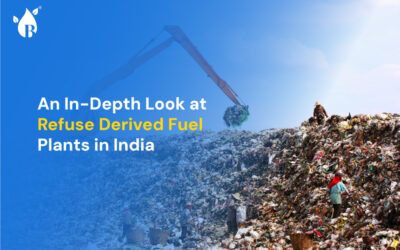
This post explores the ongoing argument about using biomass as an energy source. Some people believe it is sustainable, while others have doubts. Let’s see if biomass is really sustainable in the long run.
Around the world, organisations are looking for alternatives to the depleting reserve of fossil fuels. In this search, biomass always comes up. And it’s often considered a strong substitute to fossil fuels. But the debate around its sustainability is unanswered.
Biomass is organic material from plant and animal matter that have energy potential. Biomass is a renewable source because it has the potential to provide a continuous supply of energy. Unlike fossil fuels, this can be managed sustainably.
There are different types of biomass. The major ones are:
– Wood from forest
– Agricultural waste like crop residue
– Municipal solid waste like food waste.
– Wood from forest
– Agricultural waste like crop residue
– Municipal solid waste like food waste.
Let’s dissect forest and agricultural biomass through case studies.
Case Study: Forest Biomass Utilisation in Scandinavia
Scandinavian countries, including Sweden and Finland, have been using forest biomass since decades.
70% of Sweden’s area has forests. And about 1% of Sweden’s forest is felled annually. But for every tree harvested, 2 trees are planted to meet environmental goals.
Forest biomass in this region are:
– Logging residues
– Branches
– Small-diameter trees (which are left after timber harvesting)
– Logging residues
– Branches
– Small-diameter trees (which are left after timber harvesting)
Benefits of Forest Biomass Utilisation
Direct injection diesel engines and biodiesel are a perfect match because of their complementary properties. Biodiesel has a higher cetane rating than diesel fuel, which means it ignites more quickly and efficiently. This results in improved combustion, higher power output, and lower emissions. Biodiesel also has superior lubricating properties, which can help reduce engine wear and extend the engine’s lifespan.
1. Reducing reliance on fossil fuels: Forest biomass is considered a carbon-neutral energy source. The carbon released during combustion is offset by the carbon absorbed by trees during growth. Scandinavia has reduced dependence on fossil fuels and lowered greenhouse gas emissions.
2. Promoting forest management and sustainability: Using forest biomass incentivizes forest owners to sustainably manage their activities. It includes reforestation, selective logging, and biodiversity conservation measures.
3. Creating economic opportunities: Forest biomass has created jobs in rural areas. It supports local economies and provides an additional source of income for forest owners and operators.
Challenges and Sustainability Implications
1. Impact on biodiversity: Logging residues which are used for forest biomass, can provide habitat for biodiversity. This includes insects, fungi, and small mammals. Removal of logging residues may disrupt these ecosystems and impact biodiversity.
2. Soil nutrient depletion: Harvesting logging residues can remove important nutrients from the forest floor. This may contribute to long-term soil nutrient depletion and affect forest health.
3. Transportation impacts: Transporting biomass from remote forest areas to biomass plants results in increased carbon emissions. Other environmental impacts include soil compaction and erosion from heavy machinery.
4. Stakeholder engagement: Forest owners, operators, local communities, and environmental organisations are all involved. It’s crucial to balance the interests of them all to ensure sustainable utilisation of forest biomass.
Read this blog also: Is Biofuel Harmful to the Environment?
Case Study: Agricultural Waste Biomass Utilisation in Punjab, India
Agricultural waste biomass include crop residues, straw, husks, and shells. They are a significant source of biomass energy. Punjab is one of the leading agricultural states in India. It’s known for its intensive rice and wheat cultivation.
However, stubble burning of crop residues has been a common practice. It causes severe air pollution and environmental degradation. Awareness about agricultural waste as biomass and energy is spreading only in recent years.
The Punjab Energy Development Agency (PEDA) has programs for farmers. These programs encourage them to adopt biomass-based electricity technologies. Implementing this helps reduce air pollution as well as generates a second income for farmers.
The sustainability implications of agricultural waste biomass in Punjab are multifaceted. While it reduces air pollution and creates economic opportunities for farmers, it is also labour-intensive. Especially for small-scale farmers. Also, it’s important to leave a portion of crop residue as mulch to maintain soil health and fertility. It’s needed for long-term sustainability.
Sustainability Assessment: The Carbon Neutrality Test
Biomass is a renewable source because it comes from organic materials that can be regrown. However, to be truly sustainable, biomass should not contribute to net greenhouse gas emissions.
– Forest biomass has a higher carbon neutrality potential. It’s due to the long-term carbon sequestration capacity of forests. However, it may also have higher biodiversity conservation concerns if not managed sustainably. Forests are usually far away from biomass energy plants which also add the burden of transportation emissions.
– Agricultural waste biomass may have lower carbon neutrality potential. It’s due to the shorter regrowth cycle of crops. But it also reduces air pollution from stubble burning. And provides economic opportunities for farmers.
If biomass usage, from forest or farms, results in excess carbon emissions, carbon offset can help. They are a potential tool to mitigate the impact.
Organisations can buy carbon credits. Through that, they can invest in renewable projects to offset the emissions they generate. This also contributes to overall carbon neutrality.
Ultimately, the sustainability of biomass depends on management practices, monitoring and mitigation measures. By adopting a holistic approach, we can harness the potential of biomass as a renewable energy source.
Join the debate! Share your thoughts on whether biomass is a sustainable energy source. Let’s explore the pros and cons together and discover if it truly meets the criteria for long-term sustainability. Leave a comment and be part of the conversation!



